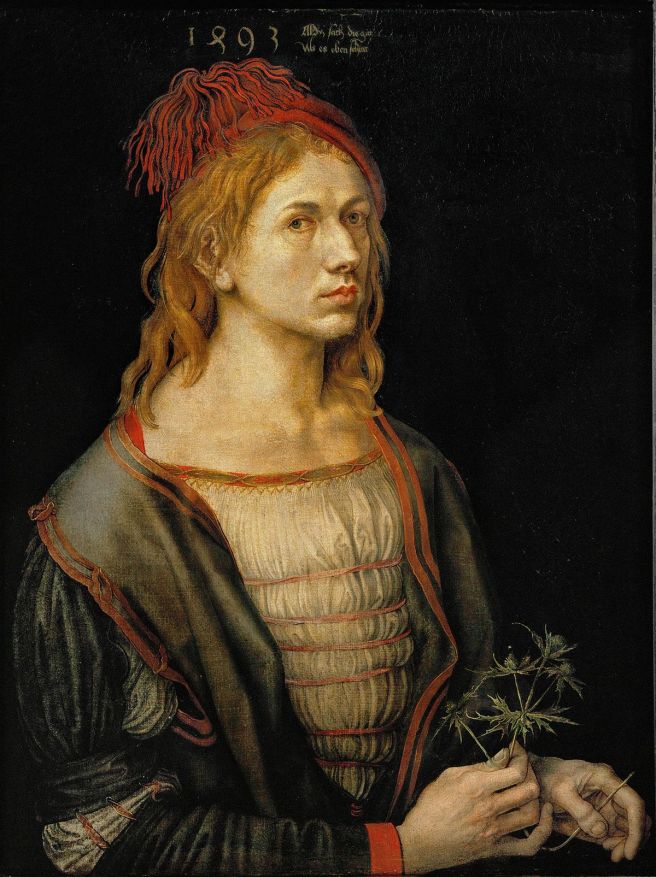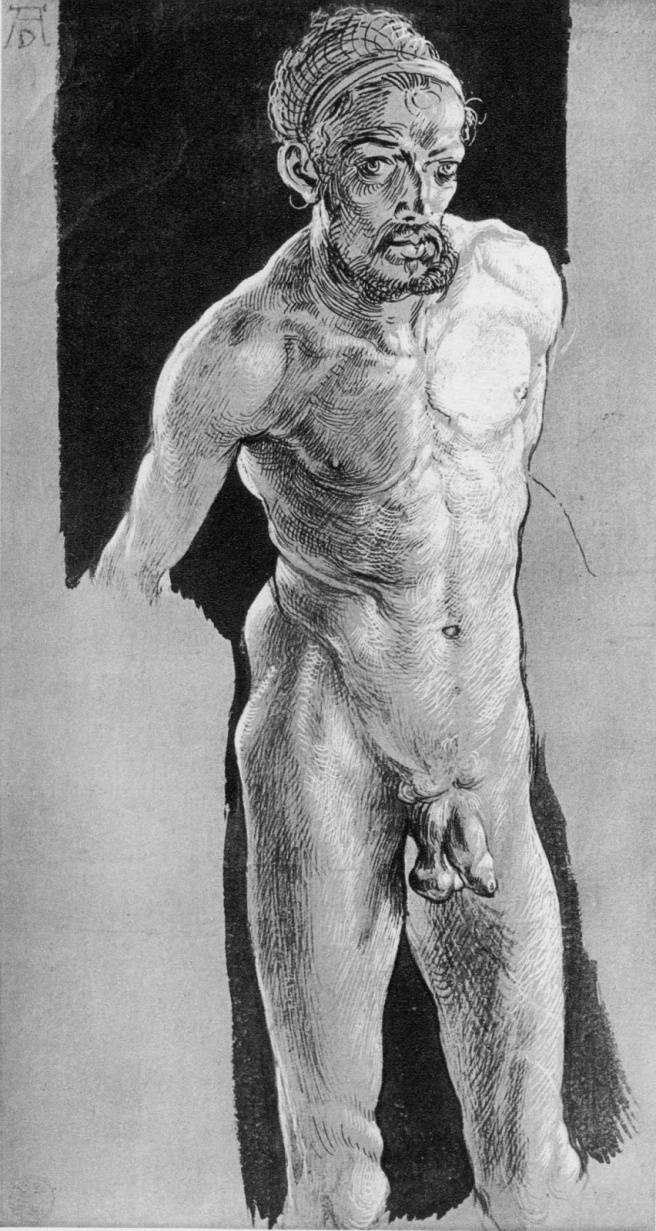![1200px-Albrecht_Dürer_-_1500_self-portrait_(High_resolution_and_detail)[1]](https://cakeordeathsite.wordpress.com/wp-content/uploads/2017/10/1200px-albrecht_dc3bcrer_-_1500_self-portrait_high_resolution_and_detail1.jpg?w=656)
Dürer’s first self-portrait is a silver-point drawing from 1484 produced when he was only thirteen. At the time he was learning the basics of goldsmithing and drawing from his father, however such was his precocious artistic talent that he became apprentice to Nuremberg’s leading artist, Michel Wolgemut, at the age of fifteen. Notice the flowing locks of hair and the long, slender, artistic fingers which would be repeatedly emphasised in a number of subsequent self-portraits.
Dürer’s first painted self-portrait is the Portrait of the Artist Holding a Thistle completed when he was 22 and probably intended as a betrothal present to his fiance Agnes Frey. The thistle was a sign of conjugal fidelity and also thought to have aphrodisiac properties.
The second painting is the Self-Portrait at 26, painted after his first journey to Italy. Here Dürer portrays himself as a man of the world and also a man of fashion. His presence dominates the setting and the landscape seen through the window and his knowing, ironic gaze stares out at the viewer with more than a hint of arrogance.
Dürer’s final and most famous painted self portrait is the powerful Self-Portrait at Twenty-Eight Years Old Wearing a Coat with Fur Collar from 1500. Here Dürer is unmistakably portraying himself as Christ. The muted tones and the fingers raised in a sign of blessing belong to the traditional depictions of Christ, as well as being half-length and frontal as opposed to the three-quarters length favoured for secular portraits. It is undoubtedly the most complex and introspective of all his self-portraits with an unprecedented psychological depth.
The rest of Dürer’s self-portraits are mainly confided to cameo appearances in other works. However in 1509 he would draw a remarkable Self-Portrait in the Nude, submitted the whole of his body to a merciless self scrutiny that wouldn’t be matched in art again until the advent of Modernism in the early 20th Century.
![durer-self-portrait-at-the-age-of-thirteen[1]](https://cakeordeathsite.wordpress.com/wp-content/uploads/2017/10/durer-self-portrait-at-the-age-of-thirteen1.jpg?w=656)

![Albrecht_Dürer_-_Self-Portrait_at_26_-_WGA6925[1]](https://cakeordeathsite.wordpress.com/wp-content/uploads/2017/10/albrecht_dc3bcrer_-_self-portrait_at_26_-_wga69251.jpg?w=656)


A master artist, child prodigy…breathtaking artwork, thank you for sharing this beautiful collection.
LikeLiked by 1 person
It is remarkable. I love Durer, truly a Renaissance man in every sense of the word. Stunning self portraits that reveal both the man and his moods. Thanks Heart
LikeLiked by 1 person
Remarkable the transformation between the man at 26 and the man at 37, not only in form but in style. But he was proficient in multiple media right? Anyway, the starkness of full nude in black and white drawing versus the colorful oils. Was this a statement of some kind? His display of proportion, perhaps? Ah, that is me being a smart ass. Good post, Mr. Cake!
LikeLiked by 1 person
Yes in woodcuts, dry points, etchings and paintings, as well writing books and being a theorist. Vasari who wrote very admirably about Durer did comment that his figures proportions could be off, as they were German. It was almost impossible to find nude models in Germany back in the day, and as Durer was proud of his face and figure modelled himself to show that he had a good grasp of proportion. So Miss Tempest, you weren’t being so smart assed at all.
LikeLiked by 1 person
Yes, I’m sure finding subjects to pose would’ve been difficult. One does need a healthy amount of self confidence to put yourself on display like that. Thank you for taking a detour into Renaissance art, Maestro Cake.
LikeLiked by 1 person
Well Durer was always the favourite Renaissance artist of the Surrealists, and he ties in very nicely with several Cake topics.
LikeLiked by 1 person
I should have known there would be a Surrealist connection. What topics? I am curious.
LikeLiked by 1 person
Hermeticism, Alchemy, visionary, apocalyptic, gothic and narcissism.
LikeLiked by 1 person
Thank you. Wouldn’t have made those connections.
LikeLiked by 1 person
I have written about Durer before in Melencholia 1 highlighting the occult influences on his art. I can send you a link if you like.
LikeLiked by 1 person
No worries. I’ll go find it.
LikeLiked by 1 person
I love especially the description of his appearance. Been to a large Dürer exhibition at the Städel in Frankfurt, it was riveting.
LikeLiked by 1 person
A true genius and Renaissance man.
LikeLiked by 1 person
About his presence. Pretty precise…
LikeLiked by 1 person
Well I notice these things.
LikeLiked by 1 person
Obviously
LikeLiked by 1 person
I try
LikeLiked by 1 person
Such a devoted life, full of curiosity and readiness to acquire new skills. I’d never seen his nude self portrait. In it he has the most direct and vulnerable gaze. In his late and much too short life he apparently questioned the role of art in religion.
LikeLiked by 1 person
He was subject to doubts, he had an enquiring mind and was in touch with a lot of humanists and artists including Raphael, Da Vinci and Erasmus. He was unquestionably devoted though. His self portraits are excellent and he really invented the genre.
LikeLiked by 2 people
I’ve marvelled at the glossy hair on the self-portrait at 28 since I first saw it.
A side question: do you have any insight into the story about the two brothers Albrecht and Albert, where the latter supposedly went to work in the mines to support his brother’s studies after having lost a coin toss? It’s touted as an urban legend, but then I haven’t actually done any research or read sources on Dürer to find whether it’s based on a germ of truth. Thought you might have gleaned something here or there.
LikeLiked by 1 person
Thank you, it is a brilliant portrait. Durer was obviously quite self assured. I have heard of the legend but I haven’t really researched it, I will correct that and will get back to in due course. Thank you for the lead.
LikeLiked by 1 person
Looking forward to it!
LikeLiked by 1 person
Mr. Cake, a superb title for your post, “Behold the Man”. All of Albrecht Dürer’s self-portraits are fantastic, the one dated 1500 is striking! He seems as though he was ‘the man’, a Renaissance man. ~ Miss Cranes
LikeLiked by 1 person
Thank you Miss Cranes, I choose the title as a reference to Ecco Homo with its allusions to religious paintings. Durer is outstanding in so many respects and his use of self portraits was truly a innovation of the highest order. It shows the emergence of the ‘artist’ as opposed to the medieval artisan. A brief detour to back in the day for me.
LikeLiked by 1 person
You’re welcome, Mr. Cake, clever and a well received title. This is a terrific detour, impressive that he stepped in front of the crowd, I think he called attention not only to the ‘artist’ but also to the ‘self’. You’ve inspired a lot of thought on this idea, and in thinking about this idea, I wonder if it was ego, innovation, or a little of both? ~ Miss Cranes
LikeLiked by 1 person
I think it was a little of both, he certainly possessed ego, but who can blame him? He was proud of his good looks, his dress sense, his learning, his ability to master so many techniques. In his lifetime he was compared by the Italians to the greats of Italian art, which in itself speaks to his brilliance. I agree he calls attention to the self, he possessed a self awareness that is common place today but was entirely new then. Also the element of self-dramatisation is novel, with the exception of the first self portrait (but to be fair he was only thirteen!) the portraits are stage managed to achieve maximum effect. Anyway I hope you agree that they are masterful works.
LikeLiked by 1 person
Truly, who could blame him, look at him! Laughing, in all seriousness he was multi-talented in the arts. In calling attention to self, it’s evident that he was also a ‘thinker’, which is even more intoxicating, good looks and a brain. Also his self-portraits created with intent to tell the viewer a story about the artist, ‘self-dramatization’, did he embellish? As to the absolute truth, who cares, the stories that these portraits tell are fascinating. And, I think for this reason they do reach their desired calculated maximum effect. Can you tell I adore Albrecht Dürer and his self-portraits?
LikeLiked by 1 person
I am so glad you agree, I like to think that my detours did keep in with the general aesthetic here…so we have Durer and Goya and Holbein rubbing shoulders with Ernst and Toyen and Man Ray. Durer was definitely a thinker.
LikeLiked by 1 person
I do, I do! Your detours are most definitely under the ‘Cake Umbrella’ of outstanding aesthetics.
LikeLiked by 1 person
You are too kind as always Miss Cranes
LikeLiked by 1 person
Honest, I hope that’s how I’ll be remembered!
LikeLiked by 1 person
I trust you will.
LikeLiked by 1 person
Wonderful art. Thank you!
LikeLiked by 1 person
Thank you glad you enjoyed
LikeLiked by 1 person
Thanks for introducing us to Dürer
His Self-Portrait Wearing a Coat with Fur Collar (1500) is remarkable… Even before I read your lines and at first sight I had a feeling od deja vu, as If I knew him.. Now I know why!… Indeed, he looks like Christ over there,. And your are so right as to his fingers slightly raised in a sign of blessing … And hisposition as well… Following the classic iconography.
Interesting to see how this artist progressively painted himself in Self Portrait, throughout the years. An interesting way to catch the aging and artistic process, as Time evolves. Great post dear Mr Cake. Love & best wishes 🙂 ❤
LikeLiked by 1 person
Thank you Aquileana. I particularly love Durer, a true Renaissance man. I think that the self portraits are incredibly important as they speak to a shift in self consciousness.
LikeLiked by 1 person